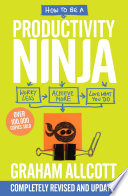

The foundation of becoming a Productivity Ninja is adopting the right mindset. This involves shifting your perspective on productivity from merely completing tasks to achieving meaningful outcomes. A Productivity Ninja embraces flexibility, adaptability, and resilience, understanding that challenges are opportunities for growth. By cultivating a growth mindset, individuals can better handle distractions and setbacks, ultimately leading to enhanced productivity. This mindset also encourages self-reflection and continuous improvement, allowing one to identify personal productivity patterns and make necessary adjustments. The book emphasizes that a positive mindset is crucial for sustaining long-term productivity, as it helps individuals maintain motivation and focus on their goals.
Continue readingThe book outlines four essential habits that form the core of a Productivity Ninja's approach: 'Do less, but better', 'Focus on the important', 'Be organized', and 'Use the right tools'. These habits encourage individuals to prioritize their tasks effectively, ensuring that they focus on what truly matters rather than getting bogged down by trivial activities. By adopting these habits, individuals can streamline their workflows, reduce overwhelm, and create a more structured approach to their daily tasks. For instance, 'Do less, but better' suggests that quality should take precedence over quantity, urging readers to eliminate unnecessary tasks and concentrate on high-impact activities. This principle is fundamental in achieving sustainable productivity.
Continue readingEffective time management is critical for productivity, and the book introduces various techniques to help individuals manage their time better. Techniques such as the Pomodoro Technique, time blocking, and the Eisenhower Matrix are discussed in detail. The Pomodoro Technique encourages focused work sessions followed by short breaks, enhancing concentration and preventing burnout. Time blocking involves scheduling specific blocks of time for different tasks, which helps maintain focus and reduces the temptation to multitask. The Eisenhower Matrix aids in prioritizing tasks based on urgency and importance, ensuring that individuals spend their time on what truly matters. By mastering these time management techniques, readers can significantly improve their efficiency and output.
Continue readingIn an increasingly distracting world, learning to manage distractions is vital for maintaining productivity. The book provides strategies for minimizing distractions, such as creating a distraction-free workspace, setting boundaries with technology, and practicing mindfulness. It emphasizes the importance of identifying personal distraction triggers and developing proactive strategies to mitigate them. For example, turning off notifications, using apps that block distracting websites, and setting specific times to check emails can help maintain focus. Additionally, the book discusses the role of mindfulness in enhancing concentration, encouraging readers to practice techniques that promote present-moment awareness and reduce mental clutter.
Continue readingProductivity is not just about managing time; it also involves managing energy levels. The book highlights the importance of understanding one's energy patterns throughout the day and aligning tasks accordingly. By identifying peak energy times, individuals can schedule their most challenging tasks during these periods for optimal performance. Furthermore, the book encourages readers to incorporate regular breaks, physical activity, and healthy eating into their routines to sustain energy levels. Recognizing the interplay between energy and productivity allows individuals to work smarter, not harder, leading to more effective outcomes and reduced fatigue.
Continue readingReflection is a crucial component of the Productivity Ninja philosophy. The book advocates for regular self-assessment and reflection on one's productivity practices, enabling individuals to learn from their experiences and make informed adjustments. This process involves evaluating what works, what doesn't, and identifying areas for improvement. By setting aside time for reflection, individuals can gain insights into their productivity patterns, recognize achievements, and set new goals. The book emphasizes that reflection fosters a growth mindset and encourages continuous learning, which is essential for adapting to changing circumstances and enhancing overall productivity.
Continue readingThe culmination of the principles discussed in the book is the development of a personalized productivity system. This system integrates the habits, techniques, and strategies that resonate most with the individual. The book provides a framework for creating this system, encouraging readers to experiment with different methods and tools to find what works best for them. By tailoring a productivity system to their unique needs and preferences, individuals can enhance their efficiency, reduce stress, and achieve their goals more effectively. The emphasis on personalization underscores the idea that there is no one-size-fits-all solution to productivity, and individuals must take ownership of their productivity journey.
Continue reading